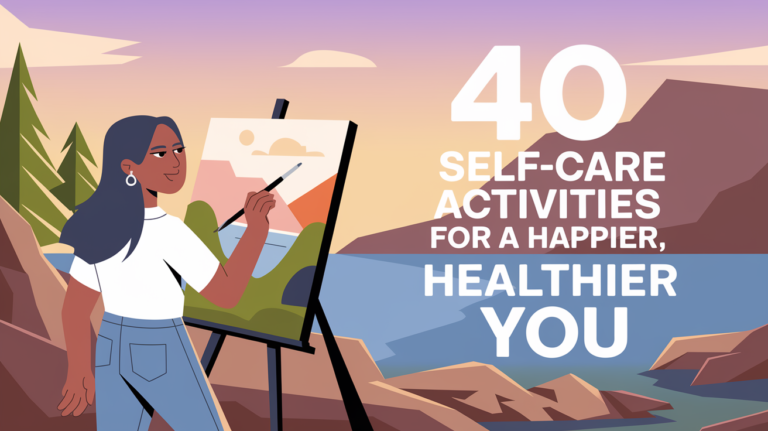Did you know 74% of adults report feeling trapped in routines that no longer serve them? That’s nearly 3 out of 4 people who wake up each day sensing they’re capable of more but unsure how to begin. Whether it’s burnout, a career plateau, or a quiet sense of “is this all there is?”—you’re not alone.
This post contains affiliate links. If you purchase through these links, I may earn a small commission at no extra cost to you. Learn more here.
This guide isn’t about quick fixes or empty promises. It’s for those ready to confront what’s holding them back and build a path aligned with their deepest values. You might’ve outgrown your current circumstances or need tools to reignite your spark. Either way, meaningful change starts with clarity.
We’ll explore practical ways to reframe your mindset, leverage your time effectively, and create momentum—even when motivation feels scarce. Think of this as a roadmap designed for real life, where progress matters more than perfection.
Feeling stuck is tough—but the right words can spark change. As you explore these 7 steps to reboot your life, why not add some powerful insights to your daily routine? With Audible’s 30-day free trial, you can listen to life-changing audiobooks while walking, commuting, or relaxing.
Start with Atomic Habits by James Clear or The 5 AM Club by Robin Sharma—two favorites among those seeking clarity and momentum.
✅ Keep one free audiobook
✅ Enjoy unlimited listening to thousands of titles
✅ Cancel anytime before the trial ends
➡️ Try Audible Free for 30 Days and turn your fresh start into lasting change.
Key Takeaways
- Feeling stagnant often signals readiness for growth, not failure
- Small, consistent actions create lasting change faster than drastic overhauls
- Clarity about personal values fuels sustainable motivation
- Practical tools exist to navigate uncertainty with confidence
- Rebuilding requires patience—and celebrating incremental wins
Understanding the Feeling of Being Stuck
That heavy sensation of inertia often starts subtly—a creeping awareness that something needs to shift, even if you can’t name it yet. Like trying to walk through waist-deep water, every effort feels disproportionate to the results. This isn’t laziness; it’s your inner self signaling misalignment.
Identifying Emotional Roadblocks
Fear often masquerades as practicality. You might notice thoughts like “This career move is too risky” or “What if I fail?” dominating your mental space. A marketing director client recently shared how self-doubt kept her from pursuing leadership roles for years, despite glowing reviews.
Perfectionism is another silent saboteur. It whispers that unless every step is flawlessly planned, action isn’t worth taking. Yet growth thrives in imperfect progress—small, deliberate choices that build momentum.
Recognizing External Pressures
Society’s invisible scripts play louder than we admit. Consider how often you’ve measured success against arbitrary timelines: “Shouldn’t I be further along by now?” A recent study found 68% of professionals feel pressured to match peers’ career trajectories, even when their values differ.
Family expectations can anchor you to paths that no longer fit. One entrepreneur delayed launching his business for a decade to meet parental ideals of “stable” employment. External noise often drowns out your inner compass—learning to separate the two becomes crucial.
Embrace Your Emotions and Mindset Changes
Imagine your emotions as weather patterns—they come and go, but you remain the sky. Resistance to discomfort often prolongs stagnation. A client once described her “stuck life” as wearing shoes two sizes too small: “I kept walking because they were familiar, not because they fit.”

Why Acceptance Matters
Research shows people who acknowledge negative feelings recover 30% faster than those who suppress them. Acceptance isn’t surrender—it’s seeing reality clearly to choose your response. When you feel stuck, labeling emotions (“This is frustration, not failure”) creates mental space for solutions.
Building Self-Compassion
Treat yourself like you’d advise a friend. One entrepreneur forgave five years of setbacks by writing: “I did my best with what I knew then.” This shift helped her get unstuck and launch her dream venture. Notice victories too—completed tasks, resisted impulses, moments of patience.
Psychologist Dr. Tara Brach’s mantra applies here: “What’s here now won’t always be.” By meeting yourself with kindness, you build the resilience needed to move forward—one conscious breath at a time.
Identify the Source of Your Obstacles
The path forward often becomes clearer when we pause to examine what’s holding us in place. Like untangling a knotted necklace, progress begins by separating internal struggles from external constraints—then addressing each strand with care.

Internal vs External Barriers
Limiting beliefs often whisper louder than reality. A client once described feeling like an imposter despite a decade of success—her internal narrative overshadowed measurable achievements. External barriers, like unsupportive workplaces or financial limitations, create tangible roadblocks. One teacher spent years in a toxic school district before recognizing how the environment stifled her growth.
Tracing the Root Causes of Stagnation
Ask: “When did I first notice this leave feeling of stagnation?” For many, patterns trace back to childhood messages or pivotal life choices. A nurse realized her career plateau began after prioritizing others’ expectations over her passion for holistic health. Spending time journaling helps uncover these hidden threads.
Consider the executive who mapped his career decisions on a timeline. He discovered fear of judgment—not lack of skill—kept him from leadership roles. By addressing this root cause, he could move forward with targeted confidence. Clarity transforms vague frustration into actionable insight.
7 Steps to Restart Your Life When You Feel Stuck
Consider the last time you navigated an unfamiliar city with a reliable map. That mix of curiosity and direction? That’s the sweet spot where transformation begins. Creating meaningful change works similarly—you need both a destination and manageable routes to get there.

Clarify Your Vision
Start by sketching your ideal future in vivid detail. What does fulfillment look like in your relationships, work, or personal growth? A tech professional I coached visualized leading remote teams while traveling—a vision that later became reality. Write three non-negotiable values guiding your choices. As author Simon Sinek notes: “People don’t buy what you do, they buy why you do it.”
Set Actionable Steps
Break broad goals into weekly experiments. Want to shift careers? Spend 20 minutes daily researching roles that align with your core values. Focus on performance-based targets like “Network with two industry professionals this month” rather than vague outcomes. This approach keeps your mind engaged without overwhelming it.
Commit to Consistent Action
Progress thrives on steady rhythms, not grand gestures. Track small wins using a habit tracker—each checkmark reinforces your capability. One writer completed her book by drafting 300 words daily before breakfast. Consistency builds momentum even when motivation wanes. Review adjustments monthly: What’s working? What needs refinement?
Remember, lasting change resembles tending a garden more than winning a race. Nurture your mindset with patience, celebrate incremental growth, and trust the process. You’re not just reaching goals—you’re becoming someone who naturally creates them.
Strategies for Realigning Your Career and Personal Life
Picture a mobile hanging above a baby’s crib—each piece maintains balance through careful adjustment. Your life works similarly. When one area dominates your energy, others tilt out of harmony. A recent Gallup study found 53% of workers feel their jobs drain vitality from personal relationships, creating a cycle of dissatisfaction.

Balancing Professional Growth and Personal Fulfillment
Start by auditing where your time actually goes. A marketing manager discovered she spent 12 weekly hours on low-impact tasks—time she reclaimed for family hikes and pottery classes. Boundary-setting becomes crucial: designate “no work” zones in your schedule, like device-free dinners or Sunday mornings.
Channel your energy intentionally. One teacher shifted from late-night grading to focused 90-minute work blocks, freeing evenings for community theater. As organizational psychologist Adam Grant notes: “Productivity isn’t about doing more—it’s about doing what matters with clarity.”
Surround yourself with people who respect your priorities. A software developer formed a “accountability pod” with colleagues pursuing side projects. They shared resources and celebrated milestones, creating momentum for meaningful change.
Remember, realignment isn’t about perfection. It’s finding a way to honor both ambition and well-being. Small tweaks—like a 15-minute mindfulness practice before meetings—often create ripple effects across all life domains.
Getting Unstuck: Practical Planning and Execution
Breaking free from stagnation requires more than good intentions—it demands a roadmap built for real life. Think of your action plan as scaffolding: it supports growth while allowing flexibility for unexpected opportunities. Start by defining what progress truly means to you, not just societal benchmarks.

Creating a Realistic Action Plan
Effective plans balance ambition with attainability. A client aiming to transition careers set monthly skill-building targets instead of rushing into job applications. This approach honored her purpose while managing energy levels. Measure success through tangible indicators: completed courses, saved funds, or networking conversations.
Lean on others‘ wisdom to expand your perspective. One entrepreneur credits her mastermind group for spotting blind spots in her business strategy. Schedule quarterly reviews to assess what’s working—adjust deadlines or methods without self-judgment.
Try this framework:
- Identify three priority areas needing change
- Break each into 90-day milestones
- Assign weekly “experiments” (e.g., research, skill practice)
- Track results in a progress journal
Remember, plans evolve as you do. What matters isn’t perfection—it’s maintaining forward motion aligned with your core values. Small, purposeful steps today create tomorrow’s breakthroughs.
Leveraging Time and Energy to Move Forward
Time and energy flow like currency—spend them wisely, and they compound into progress. Many people struggle not from lack of effort, but from mismanaging these finite resources. The key lies in designing routines that honor both ambition and well-being.

Budgeting Your Time Effectively
Think of your week as 168 blank minutes waiting for intention. A project manager client reclaimed 10 hours monthly by color-coding her calendar: blue for deep work, green for meetings, yellow for personal time. Tangible tools like planners or apps make abstract times concrete. Try blocking 25-minute focus sprints followed by 5-minute breaks—research shows this rhythm sustains momentum better than marathon sessions.
Prioritizing Self-Care and Productivity
Self-care isn’t selfish—it’s strategic. Schedule 15 minutes daily for activities that replenish you, whether walking or journaling. One entrepreneur discovered midday meditation reduced afternoon decision fatigue by 40%. Notice how certain thoughts (“I should work longer”) drain energy versus purposeful actions (“I’ll tackle this after a reset”).
Track your feelings alongside tasks for three days. You might spot patterns—like post-lunch energy slumps—that signal when to schedule creative work versus admin. Small tweaks create ripple effects. As author Laura Vanderkam observes: “We build the lives we want by protecting what matters first.”
Mastering Your Mindset for Positive Change
Progress often stalls not from lack of effort, but from patterns of thinking that keep us circling familiar ruts. Psychologist Susan David calls this “emotional rigidity”—clinging to mental habits that once served us but now limit growth. The good news? Mindsets aren’t fixed traits. They’re skills we can reshape through deliberate practice.

Rewiring Procrastination Patterns
Tim Ferriss famously recommends asking: “What would this look like if it were easy?” This simple reframe helps bypass overwhelm. A client struggling to launch a side project started dedicating 10 minutes each day to research—tiny points of progress that eventually built her confidence to take bigger leaps.
Consider how friends influence your momentum. One writer credits her accountability partner for spotting when perfectionism paralyzed her progress. Their weekly check-ins became a safe space to celebrate imperfect drafts rather than judge unfinished work.
Each day offers a reset button. Maybe today’s thing is deleting one app draining your focus, or having a candid chat with a mentor. Author James Clear notes: “Habits are votes for the person you want to become.” What small vote could you cast right now?
Notice when you label tasks as “shoulds” versus “coulds.” This subtle shift—from obligation to choice—reduces resistance. A teacher transformed his grading routine by pairing it with favorite music, turning a chore into a mindful ritual. Progress thrives when we stop fighting ourselves and start partnering with our potential.
Taking Action: Consistency is Key to Progress
Think of your daily actions as musical notes—individually small, but together they compose the symphony of progress. Momentum builds through control over routines, not grand gestures. A client once described her breakthrough as “showing up imperfectly, but showing up daily.”

Establishing Daily Routines for Success
Effective structures prevent backsliding. One writer overcame creative blocks by dedicating 7:30–8:00 AM to brainstorming—no emails, no distractions. Within weeks, this ritual generated enough insights to complete her manuscript. Her secret? “Protect the first hour for what matters most.”
When feeling stuck life tries to derail you, lean on micro-commitments. A teacher battling burnout started with five-minute meditation sessions. Over time, these pockets of calm expanded into sustainable energy management. Track progress visually—a wall calendar with gold stars for completed tasks works wonders.
Consider these preventive measures:
- Schedule “reset breaks” between work blocks
- Pair challenging tasks with enjoyable rewards
- Review weekly wins every Sunday night
Documenting your journey provides crucial insights. One entrepreneur spotted patterns in her energy dips by color-coding her planner. This awareness helped her regain control over unproductive cycles. Remember—even on days you feel stuck life pressing in, showing up matters. As author Seth Godin notes: “Consistency is far more powerful than rare moments of greatness.”
Adapt these simple habits to your rhythm. What three-minute practice could anchor your tomorrow? Start there, then build.
Stories and Insights from Real-Life Experiences
What if the key to moving forward lay in understanding how others navigated similar crossroads? Take Maya, a former accountant who felt like her career had flatlined. By joining a co-working space’s mentorship program, she discovered her knack for UX design—now she leads projects helping nonprofits streamline donor systems.

Learning from Personal Journeys
Jake’s story resonates with many ’re feeling disconnected from their work. After losing his restaurant during the pandemic, he documented his reinvention journey on social media. Followers became collaborators—together, they launched a food truck collective supporting first-time entrepreneurs. “Sharing the messy middle built trust,” he reflects. “People root for authenticity more than perfection.”
Inspiring Examples of Transformation
Consider Dr. Amina, a pediatrician who redesigned her schedule to mentor teens in underserved communities. She found her sense purpose reignited by balancing clinical work with advocacy. Or Tara, who turned her knitting hobby into a therapy program for anxiety sufferers after realizing ’re feeling isolated needed creative outlets.
These stories share a thread: moving forward often starts by redefining what’s possible. Notice how each person leaned into community when they felt like giving up. Even curated social media groups can spark ideas—one teacher credits TikTok educators for inspiring her classroom revamp.
Your turn: What small step today could plant seeds for tomorrow’s sense purpose? Progress isn’t about dramatic leaps—it’s choosing to begin.
Conclusion
Every journey begins with recognizing you’re already holding the map. The strategies we’ve explored—from aligning actions with core values to designing purposeful routines—offer tools to navigate uncertainty with clarity. Managing your time energy wisely creates space for both growth and renewal.
Remember, progress thrives in small, consistent choices. Those 15 minutes of free time spent journaling or stretching? They’re a great way to fuel resilience. Reviewing goals weekly may also help spot patterns needing adjustment, while celebrating minor wins builds momentum.
You hold more power than you realize. Each mindful decision chips away at stagnation, revealing paths you couldn’t see from yesterday’s vantage point. Trust the process, lean into curiosity, and remember: transformation isn’t about perfection—it’s showing up for yourself daily. Take that first intentional breath. Your next chapter starts now.
🎧 Enhance Your Journey with Audible
Embarking on a journey of personal growth can be both exciting and challenging. To support you along the way, consider integrating audiobooks into your daily routine. They offer flexibility, allowing you to absorb insightful content during commutes, workouts, or while relaxing at home.
Audible provides a vast selection of audiobooks, including bestsellers and exclusive content. With their 30-day free trial, you can:
- Select any audiobook from their extensive collection to keep.
- Enjoy unlimited listening to thousands of titles, including Audible Originals and podcasts.
- Experience flexibility, as you can cancel anytime before the trial ends without any charges.
After the trial, membership continues at $7.95/month, but you can cancel online anytime.
For those seeking inspiration, consider starting with:
- Atomic Habits by James Clear: Discover practical strategies to build good habits and break bad ones.
- The 5 AM Club by Robin Sharma: Learn about the transformative power of early rising and how it can elevate your life.
Disclosure: As an Amazon Associate, I earn from qualifying purchases.







